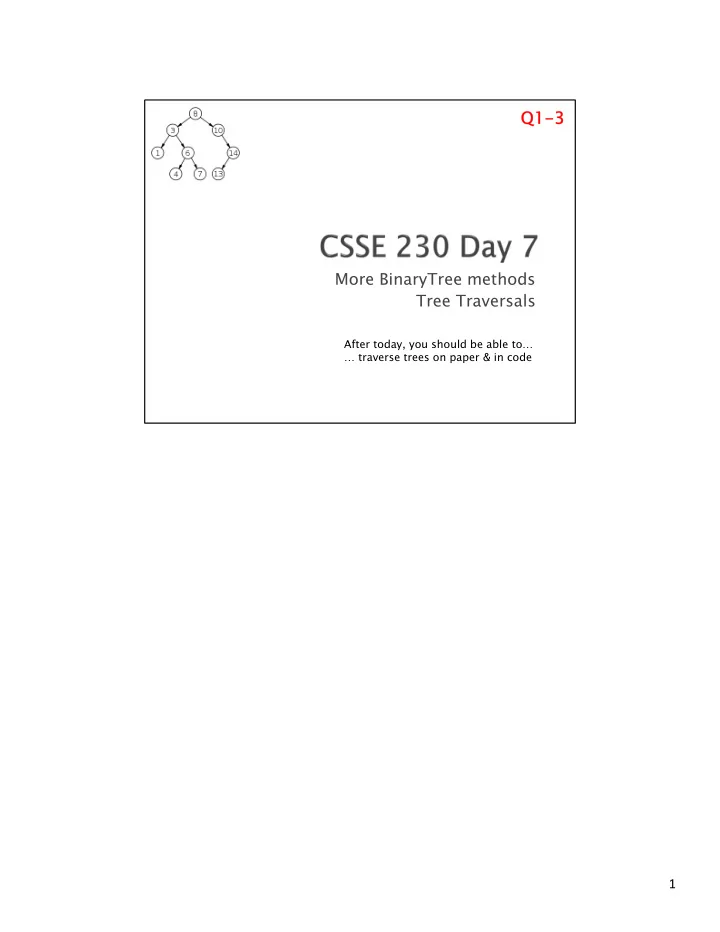

Q1-3 Q1-3 More BinaryTree methods Tree Traversals After today, you should be able to… … traverse trees on paper & in code 1
Please complete the Stacks&Queues partner evaluation in Moodle after you submit your final code. Due soon after you submit the project (or by Thursday night). Doublets is next programming assignment. Solve it with a partner – meet later during today's class. Instructor demo later too. Questions (Exam, Stacks & Queues, HW3)? Move to day 6 2
Quiz question: What became clear to you as a result of class? CSSE230 student: I was tre treeted to some good knowledge by the time I leaf leaft. Casey Dant, 201410. 3
NULL_NODE 1 possibility for children: Both 4 possibilities for children (leaf, Left only, Right only, Both) (which could be NULL_NODE) 4
Simpler Simpler 5
Comment out unused tests and uncomment as you go Write containsNonBST(T item) now. Have students create new project for doing this. [[[See BinaryTreeInClassSolution for code.]]] Another approach is in BinaryTreeWithNullNode. {{CWA: I started without the null node, wrote size, pointed out how ugly it was, introduced The null node, fixed size(), then continued to do the other methods. Have them write contains(), then live code contains() to check. Point: recursion is your friend. Get good at it! 6
If (node is null) ◦ Return something simple Recurse to the left Recurse to the right Combine results with this node 7
If (node is null) ◦ Return something simple Recurse to the left Recurse to the right Combine results with this node 8
If (node is null) ◦ Return something simple Recurse to the left Recurse to the right Combine results with this node 9
Print the tree If (node is null) contents ◦ Return something Sum the values of simple the nodes Dump the contents Recurse to the left to an array list Recurse to the right Lots more Combine results with this node In what order should we print nodes? 10
4-7 4-7 InOrder (left-to-right, if tree is spread out) ◦ Left, root, right PreOrder (top-down, depth-first) ◦ root, left, right PostOrder (bottom-up) ◦ left, right, root LevelOrder (breadth-first) ◦ Level-by-level, left-to-right within each level Make up a tree and show the 4 walks through examples on board, have them do quiz questions after each one on the board. Point out level order is different! Implement at least one of them (inorder?) as toString() in the project. Hard to get spaces right if NULL_NODE, so practice before class. In Binary Tree: println("Inorder Traversal:" printInOrder(this.root); The write PrintInOrder in BinaryTree to begin with if (this != BinaryTree.NULL_NODE) 11
If the tree has N nodes, what’s the (worst- case) big-Oh run-time of each traversal? O(N) O(N) for stack frames 12
8 Brainstorm how to write: public ArrayList<T> toArrayList() Then BST toString() will simply be: return toArrayList().toString(); Have them sketch algorithm for toArrayList, then do it together. Use it for toString. 13
Size(), height(), contains(), toArrayList(), toString(), etc. What if we want an iterator (one element at a time)? Next class 14
15
Recommend
More recommend